This is a list that is near and dear to me. I have always been an advocate of early cinema. During its earliest days there was little distinction between motion picture and high art. Many early innovators of film were also provocateurs and students of the Avant-garde. It wasn’t until the talkies came along in the late 20s and the Production Code was written and enforced in the 30s that motion pictures lost their early edginess. Back in the silent era, films were often glorious and gritty fare, driven by their visuals and crafted as cinematic poetry.
 But where is a good place to start when first exploring the silent age? With the recent popularity of The Artist and Hugo, the time may be right for a list of silent films that are perfect to serve as an introduction to silent films.
But where is a good place to start when first exploring the silent age? With the recent popularity of The Artist and Hugo, the time may be right for a list of silent films that are perfect to serve as an introduction to silent films.
I avoided some cinematic landmarks like the Lumière Brothers and Edison. Though they were critical in pushing the technology of the medium, most of their pieces feel like tests, which they often were. Then there were undisputed masters such as G.W. Pabst and Sergei Eisenstein that I left off the list as well. Battleship Potmekin and Pandora’s Box may be stunning achievements, but you don’t start out reading Moby Dick or watching Citizen Kane. Just know that there is a lot more great work out there, and feel free to share your favorites in the comments below.
Without any further stalling, here are my Top 10 Silent Films to Start With.
10. Broken Blossoms (1919)
Directed by D.W. Griffith
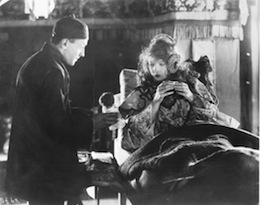 Because of Birth of a Nation, D.W. Griffith will always be the genius racist of early cinema, but the man was a charismatic powerhouse that knew how to tell a story. His penchant for grand visuals was seen throughout Birth of a Nation and his cinematic penance, the stunning epic Intolerance. Though cases could be made for either Birth of a Nation or Intolerance, both are over four hours long, an intimidating length even for the most passionate film lover.
Because of Birth of a Nation, D.W. Griffith will always be the genius racist of early cinema, but the man was a charismatic powerhouse that knew how to tell a story. His penchant for grand visuals was seen throughout Birth of a Nation and his cinematic penance, the stunning epic Intolerance. Though cases could be made for either Birth of a Nation or Intolerance, both are over four hours long, an intimidating length even for the most passionate film lover.
Broken Blossoms is a cohesive and engaging drama about two social outcasts, a Chinese immigrant and the abused daughter of a drunk boxer. Both find friendship with each other until the father finds out. The ending is tragic and beautiful and the whole film clocks in at a reasonable 90 minutes. Though it is a flawed film, Broken Blossoms is still a solid work from Griffith, and should satisfy lovers of tense emotional dramas.
9. The Thief of Bagdad (1924)
Directed by Raoul Walsh
 For lovers of adventure films, The Thief of Bagdad should be an eye-opening delight. From the kitschy cool of Ray Harryhausen’s 70s masterpieces or the epic epicness of Peter Jackson’s Lord of the Rings trilogy, Walsh’s 20s adventure film will show you just how unoriginal these later works were.
For lovers of adventure films, The Thief of Bagdad should be an eye-opening delight. From the kitschy cool of Ray Harryhausen’s 70s masterpieces or the epic epicness of Peter Jackson’s Lord of the Rings trilogy, Walsh’s 20s adventure film will show you just how unoriginal these later works were.
It’s a classic adventure tale about a thief, played by Douglas Fairbanks, who falls in love with a princess and must defeat an evil Mongol prince by completing a series of impossible tasks. Yes, this is the inspiration for Disney’s Aladdin, and the similarities, except musical numbers, are striking.
Raoul Walsh is also an important figure in cinema because he later directed gangster films, westerns, and worked with James Cagney, Cary Grant and Clark Gable. He is early cinema’s predecessor to the likes of Martin Scorsese, George Lucas and Steven Spielberg.
The Thief of Bagdad is two and a half hours long, but if you’re the type of person who made it through the extended editions of LOTR, you’ll have no problems with this.
And it’s available to stream on Netflix.
8. The Cabinet of Dr. Caligari (1920)
Directed by Robert Wiene
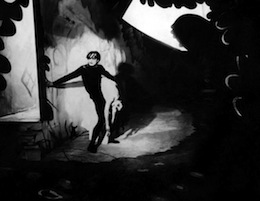 If the Tim Burton of late just feels like a sad reflection of his glory days of Beetlejuice or Edward Scissorhands, then I have the tonic that will soothe what ails you. It’s the O.G. dark head-trip king, Robert Wiene, and his classic The Cabinet of Dr. Caligari.
If the Tim Burton of late just feels like a sad reflection of his glory days of Beetlejuice or Edward Scissorhands, then I have the tonic that will soothe what ails you. It’s the O.G. dark head-trip king, Robert Wiene, and his classic The Cabinet of Dr. Caligari.
The doctor puts on a traveling carnival act with his partner Cesare, a fortune-telling somnambulist. Cesare correctly predicts a murder the next night, which prompts panic and suspicion throughout the town. The story is tense and the visuals are mind-altering to say the least. The German Expressionists were masters at showing anxiety and terror through their visual constructions, and Wiene’s greatest film is a glowing example of that.
It is also available to stream on Netflix.
7. Modern Times (1936)
Directed by Charles Chaplin
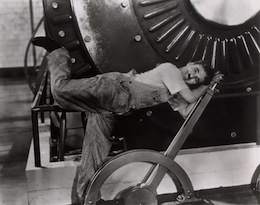 It was 1936 and talkies were in full swing, but Charlie Chaplin would have none of it. When the studio insisted on sync sound dialogue, Chaplin stuck in a minor exchange between a factory owner and a worker into Modern Times. In spite of this moment, the film is otherwise entirely silent and the story moves forward on the strength of its visuals.
It was 1936 and talkies were in full swing, but Charlie Chaplin would have none of it. When the studio insisted on sync sound dialogue, Chaplin stuck in a minor exchange between a factory owner and a worker into Modern Times. In spite of this moment, the film is otherwise entirely silent and the story moves forward on the strength of its visuals.
The consummate early visionary, Chaplin was a master at making a point with a single visual. In Modern Times Chaplin’s factory worker struggles to live in the mechanized modern world. To put a fine point on it, the factory worker is sucked into a giant machine and performs an intricate mechanical ballet with the other cogs and wheels.
The Gold Rush might be more famous, but Modern Times was not only edgier, but making a contemporary statement against the cinema of its day. Add to that the stunningly beautiful Paulette Goddard and Modern Times is a winner.
If you have Hulu+ you can watch Modern Times right now.
6. Sherlock Jr. (1924)
Directed by Buster Keaton
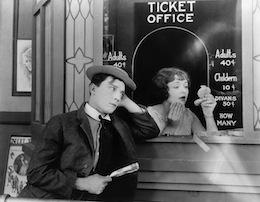 Chaplin tends to get the spotlight when it comes to silent era frivolity, but let’s not forget our friend Buster Keaton. People will often give a nod to his most famous film (and in just a few moments I will too), but Sherlock Jr. is an absolute gem.
Chaplin tends to get the spotlight when it comes to silent era frivolity, but let’s not forget our friend Buster Keaton. People will often give a nod to his most famous film (and in just a few moments I will too), but Sherlock Jr. is an absolute gem.
Keaton plays a projectionist in love with a local girl, but he is framed for stealing her father’s watch. He tries to solve the crime, but to no avail. He retreats to his job and while the reels run, he dreams that he is a famous solver of crimes. It’s delightful.
Some of the visual transitions are unbelievable and shame even 2012’s technological best. It’s only 45 minutes long and available to stream online. I don’t know why you’re not already watching it.
5. La Diable Noir – The Black Imp (1905) and Le Voyage dans la Lune – The Voyage to the Moon (1902)
Directed by Georges Méliès
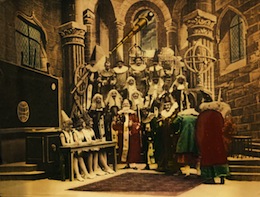 When I was watching Hugo my biggest problem with it was that the whole time I would have rather been watching one of George Méliès films instead. They are fun, whimsical, and exciting. They are like the best of the Merry Melodies or Looney Tunes and they were live action and shot 30 years earlier.
When I was watching Hugo my biggest problem with it was that the whole time I would have rather been watching one of George Méliès films instead. They are fun, whimsical, and exciting. They are like the best of the Merry Melodies or Looney Tunes and they were live action and shot 30 years earlier.
All of Méliès films were short, which makes them easy to watch, but some are so stunning that you wish they would just keep going. Many of the films have been restored. Some have even been re-tinted, so you can choose which versions you prefer. Since the musical tracks that accompanied the pieces were not always noted, you can watch the same short film with a variety of accompaniments. Each film is good and with the extensive variety in the ways each one is presented, it’s easy to grow fond of Méliès work quickly.
Here are some of Méliès films on Youtube.
4. Nosferatu (1922)
Directed by F.W. Murnau
 I can’t forget you genre junkies out there, and why would I when one of the greatest films of the silent era also falls into the horror/vampire genre.
I can’t forget you genre junkies out there, and why would I when one of the greatest films of the silent era also falls into the horror/vampire genre.
It’s become hip to reference F.W. Murnau’s first American film, Sunrise, and I’m not going to deny the power and artistry of that film, which sat on the brink of an auditory ground shift in cinema, but for sheer visceral pleasure and a heaping helping of visual artistry, Nosferatu still packs a punch.
Max Schreck as the vampire is creep-tastic. He takes what many often perceive as a weakness in silent films – the overly stagey and dramatic facial gestures – and takes them to a disturbing level. Murnau’s compositions are stark and wonderful, and I wish that any vampire flick of today could be half as well made as Nosferatu. There are even some really effective special effects too.
You can watch versions on either Hulu or Netflix.
3. Metropolis (1927)
Directed by Fritz Lang
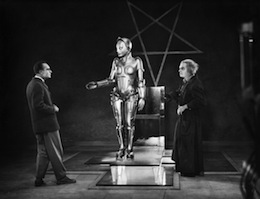 We now jump from one genre to another, from horror to science fiction, from Nosferatu to Metropolis. These are some of the most formative works in cinema. Both paved the road down which filmmakers still travel.
We now jump from one genre to another, from horror to science fiction, from Nosferatu to Metropolis. These are some of the most formative works in cinema. Both paved the road down which filmmakers still travel.
Every time I watch Metropolis I’m blown away by how much this single film influenced numerous generations of filmmakers. From the art direction, to the visions of a dystopian future, to the class struggles that pervade the culture in the film, this single work from Fritz Lang is packed with a ton of stuff.
Add to that roof top chases, robot doppelgänger girlfriends, fistfights, and riots in the street. If you want to watch something snooty and pretentious or something that has action and just kicks ass, Metropolis has got you covered. It’s a great film that should satisfy a huge range of people.
It’s also available to stream on either Hulu or Netflix.
2. The General (1926)
Directed by Buster Keaton and Clyde Bruckman
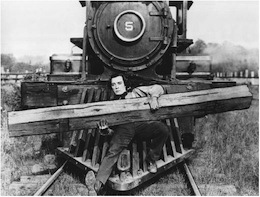 For the final two films, we revisit a couple of directors who appeared earlier on the list. These two fellows are true geniuses of the silent era, and to be completely honest either film is a toss up for the most approachable silent film ever.
For the final two films, we revisit a couple of directors who appeared earlier on the list. These two fellows are true geniuses of the silent era, and to be completely honest either film is a toss up for the most approachable silent film ever.
But one of them has to go in the two slot so I offer you Buster Keaton’s The General.
Keaton plays a young southerner who joins to Confederacy to gain the attention of his sweetheart. Through a series of amazing events he accidentally outruns the Union forces, saves his beloved and his hometown.
The visuals are so good, I can all but guarantee you won’t realize you’re watching a silent film. The protagonist is a stoic silent fellow and you just don’t need the dialogue.
Oh and there are train chases, cannon antics, and stunts galore. Keaton even crashes a multi-ton train engine into a gorge. It’s still where it landed all these years later. If you love physical comedy, then get ready because The General is gonna own you.
1. City Lights (1931)
Directed by Charles Chaplin
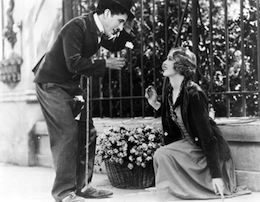 The final film on the list is not only one of the best silent films ever made it is arguably one of the greatest films of all time. City Lights shows a mastery of visual storytelling, complete control of composition and frame, subtlety of performance and gives the viewer a wonderful story that still resonates today.
The final film on the list is not only one of the best silent films ever made it is arguably one of the greatest films of all time. City Lights shows a mastery of visual storytelling, complete control of composition and frame, subtlety of performance and gives the viewer a wonderful story that still resonates today.
Chaplin’s Tramp falls in love with a blind girl, who mistakes him for a millionaire. He keeps the façade going, but when he offers to pay for the surgery that can cure her blindness, he has to actually come up with the money. It’s funny and emotionally compelling. Never once does the story feel out of date or antiquated, and the ending – well it’s just one of the single most iconic moments in all of film history.
If City Lights can’t open your eyes to the wealth of content in early cinema, then you probably can’t be convinced. If that’s the case then I’m sorry for your loss. To the rest of you, enjoy.
City Lights is available to stream on Hulu+.







{ 5 comments }
Couldn’t agree more with The General – amazing flick.
I’m surprised to see that Sunrise: A Tale of Two Humans didn’t make the list. I suppose its probably because its the only silent film I’ve seen that I consider it a good place to start and probably a common one thanks to AFI’s list. Thank you for the link to the Melies films as well I didn’t even think that they would be on youtube
sorry obviously “a song of two humans”
Sunrise is definitely worth watching, but I hesitated offering it as an introduction. It’s beautiful and expertly crafted, but it might feel long to the silent newcomer. I do agree that it’s an impressive film though.
I agree with “Metropolis” part of my inspiration comes from that. I just wish the entire film were around today.
Comments on this entry are closed.